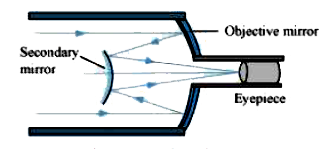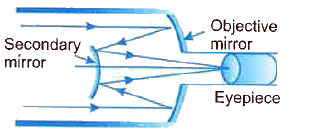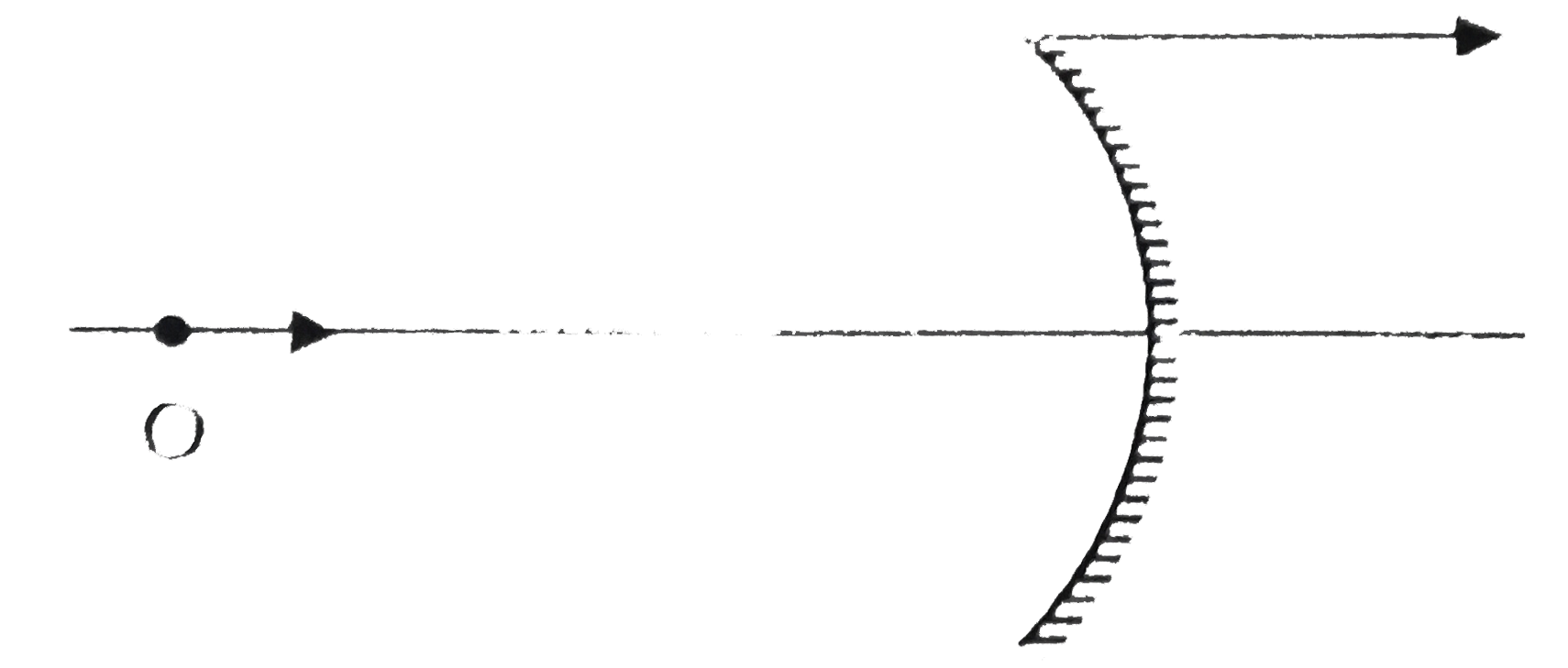A Cassegrainian telescope uses two mirrors as shown in Fig. Such a telescope is built with the mirrors 20mm apart. If the radius of curvature of large mirror is 220mm and the small mirror is 40mm, where will the final image of an object at infinity be ?
The following figure shows a Cassegrain telescope consisting of a concave mirror and a convex mirror.
 Distance between the objective mirror and the secondary mirror, d=20mm Radius of curvature of the secondary mirror, R1=140mm
Distance between the objective mirror and the secondary mirror, d=20mm Radius of curvature of the secondary mirror, R1=140mm
Hence, focal length of the secondary mirror, f2=R22=1402=70mm
The image of an object placed at infity, formed by the objective mirror, will act as a virtual object for the secondary mirror. Hence, the virtual object distance for the secondary mirror, μ=f1−d
110−20=90mm
Applying the mirror formula for the secondary mirror, we can calculate image distance (v) as
1v+1u=1f2
1v=1f2−1u
−170−190=9−7630=2630
∴v=6302=315mm
Hence, the final image will be formed 315 mm away from the secondary mirror.
Topper's Solved these Questions
- BOOK - NCERTCHAPTER - RAY OPTICS AND OPTICAL INSTRUMENTSEXERCISE - Exercise32videos
RAY OPTICS AND OPTICAL INSTRUMENTS
- BOOK - NCERTCHAPTER - NUCLEIEXERCISE - Exercise31videos
NUCLEI
- BOOK - NCERTCHAPTER - SEMICONDUCTOR ELECTRONICS MATERIALS DEVICES AND SIMPLE CIRCUITSEXERCISE - Exercise15videos
SEMICONDUCTOR ELECTRONICS MATERIALS DEVICES AND SIMPLE CIRCUITS
Similar Questions
A Cassegrain telescope uses two mirrors as shown in Fig. 9.10. Such a telescope is built with the mirrors 20 mm apart. If the radius of curvature of the large mirror is 220 mm and the small mirror is 140 mm, where will the final image of an object at infinity be ?
 View Solution
View SolutionThe radius of curvature of a concave mirror is 50 cm. Where should an object be held from the mirror so as to form its image at infinity?
View Solution
Knowledge Check
- Question 1 - Select One
A convex mirror forms a real image 5 times the size of the object placed at a distance of 20cm from it. The radius of curvature of the mirror is
A1003cmB503cmC100cmD50cm - Question 2 - Select One
An object is 100 mm in front of a concave mirror which produces an upright image (erect image). The radius of curvature of the mirror is :
Aless than 100 mmBbetween 100 mm and 200 mmCexactly 200 mmDmore than 200 mm - Question 3 - Select One
A slab of glass, of thickness 6 cm and refractive index 1.5, is placed in front of a concave mirror, the faces of the slab being perpendicular to the principal axis of the mirror. If the radius of curvature of the mirror is 40 cm and the reflected image coincides with the object, then the distance of the object from the mirror is
A30 cmB22 cmC42 cmD28 cm
The radius of curvature of a concave mirror is 50 cm. Where should an object be placed from the mirror so as to form its image at infinity ?
View SolutionIn a Cassegrainian telescope, ……………………. is a large concave mirror.
View Solution
An object kept on the principle axis is moving in the sme directions as that of mirror as shown in the figure. Speed of object and mirror is 10ms and 4013ms. Radius of the curvature of the mirror is 20 cm. If the distance of object from the mirror at this instant is 5x cm, velocity of image at this instant is found to be zero. Find x.View SolutionA slab of glass, of thickness 6 cm and refractive index 1.5, is placed in front of a concave mirror, the faces of the slab being perpendicular to the principal axis of the mirror. If the radius of curvature of the mirror is 40 cm and the reflected image coincides with the object, then the distance of the object from the mirror is
View SolutionThe radius of curvature of a convex mirror is 'x'. The distance of an object from focus of this mirror is 'y'. Then what is the distance of image from the focus ?
View Solution

